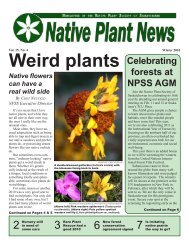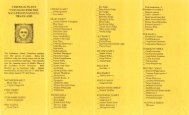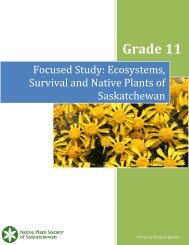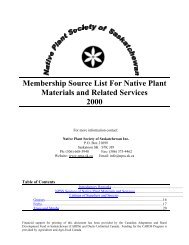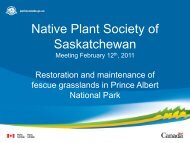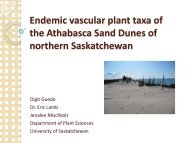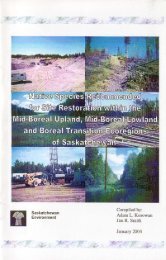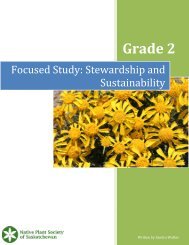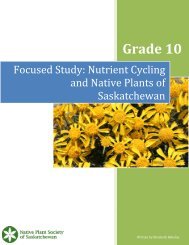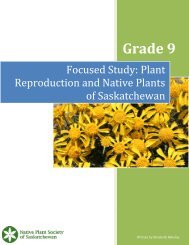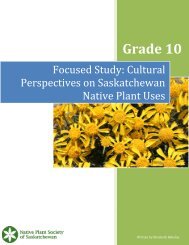Saskatchewan Guidelines For Use Of Native Plants In Roadside ...
Saskatchewan Guidelines For Use Of Native Plants In Roadside ...
Saskatchewan Guidelines For Use Of Native Plants In Roadside ...
Create successful ePaper yourself
Turn your PDF publications into a flip-book with our unique Google optimized e-Paper software.
<strong>Saskatchewan</strong> <strong>Guidelines</strong> <strong>For</strong> <strong>Use</strong> <strong>Of</strong> <strong>Native</strong> <strong>Plants</strong> <strong>In</strong> <strong>Roadside</strong> Revegetation<br />
Field Guide<br />
- Not widely used with native species; <strong>Saskatchewan</strong> case studies/successes<br />
limited.<br />
- Variable seeding rate, some over-seeded/under-seeded areas.<br />
- Five times the normal amount of seed is required because of wasteful dispersal,<br />
which is costly.<br />
Ultimately it is a judgment call; however, the most widely-used method is the drill<br />
seeding method, probably due to the consistent seeding rate and good seed placement,<br />
allowing better germination. <strong>Native</strong> hay spreading is probably the least-used method due<br />
to a lack of native hay and uneven seed dispersal and germination. Combinations of<br />
various seeding methods may also be used effectively, although sites are typically<br />
restored using only one method.<br />
II. Post-Construction Site Preparation<br />
Once construction has ceased and you are ready to revegetate the site, go and inspect the<br />
site one last time. Take photos, again from the same location that previous photos were<br />
taken from and record your observations. Once this is finished, follow these steps:<br />
1. Weed Control<br />
If there are any perennial or noxious weeds present, apply an appropriate herbicide at the<br />
recommended rate. Consult the <strong>Saskatchewan</strong> Ministry of Agriculture’s annuallyupdated<br />
“Guide to Crop Protection” for the appropriate herbicide types and application<br />
rates.<br />
2. Soil Preparation<br />
Prepare the soil so that it makes a satisfactory seedbed. The ideal seedbed should be firm<br />
enough so that a footprint is barely visible (92). If the soil is quite loose, packing will be<br />
required, as the seed needs a firm bed. Two passes, one perpendicular to the other,<br />
ensures even packing. If the soil has been highly compacted from heavy machinery, the<br />
soil will need to be tilled using either a discer or cultivator apparatus. If large clods of<br />
soil remain after tilling, these will have to be broken down so that the area has an overall<br />
uniform, fine texture. After tilling, the soil will then need packing. If erosion is a serious<br />
concern, wheat or barley straw (or straw from similarly innocuous cereal crops) may be<br />
crimped into the soil surface and seeded over without impacting seedling establishment.<br />
Straw crimping and laying fibre matting may also be done after seeding is complete.<br />
Refer to section III, Revegetation, for a list of equipment needed.<br />
The exception to the soil preparation mentioned above is if the seed is to be broadcast. <strong>In</strong><br />
this case, soil should be loose prior to broadcasting, and packing should follow after<br />
seeding is complete. The packing action will press the seed into the soil, reducing its<br />
exposure to predation and the elements, and ensuring good seed to soil contact.



